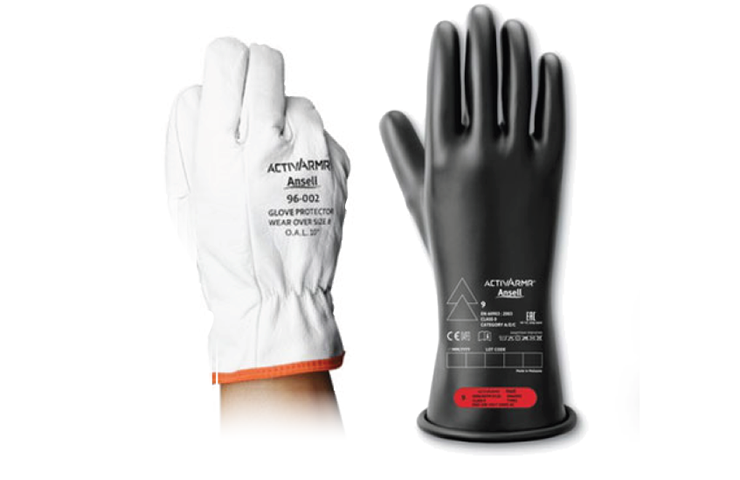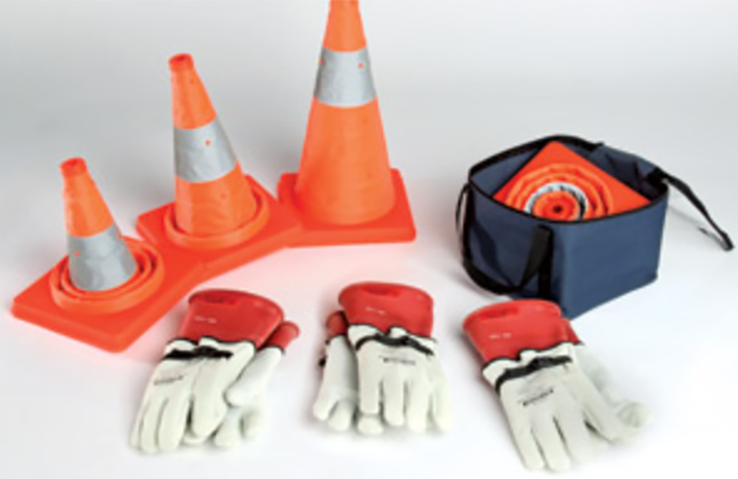When working on any high voltage system on a GM vehicle, certified and tested high voltage insulation gloves must be worn. (Fig. 9) Certified and up-to-date Class “0” insulation gloves rated at 1000V with leather protectors provide an insulative barrier between an electrical point and the skin of an individual.
 Fig. 9
Fig. 9
Wear the insulation gloves at all times when working with the high voltage battery assembly, wires and components, whether the system is energized or not. It’s recommended to use the “one-hand rule” whenever possible, which involves working with only one hand while the other hand is behind your back.
Inspection Procedure
Before each use, the insulation gloves should be removed from their leather protector gloves and visually and functionally inspected. Refer to the High Voltage Insulation Glove Inspection Procedure in the appropriate Service Information.
TIP: The leather protector gloves by themselves do not offer any protection against high or low voltage. Always wear the outer leather protector gloves over the inner rubber insulator gloves.
Rubber insulating gloves include a stamped date indicating when the gloves were “originally or last tested electrically.” Rubber insulating gloves must be re-tested electrically by a certified lab 6 months after first use. The lab will re-stamp the gloves with the new “tested” date.
- New gloves and sleeves are marked with the date of manufacture/electrical test and are acceptable for use 12 months from that date.
- If new gloves are first used within 12 months of the manufacture/electrical test date, re-certification must occur 6 months from first use. The first use date should be recorded.
- If the first use date is not known, the gloves/sleeves must be retested 6 months from the electrical test date stamped on the glove/sleeve.
If the gloves certification age range has expired, do not use the gloves. The gloves should be tested and recertified or replaced. For the North America region, visit www.nail4pet.org to find an accredited re-certification laboratory.
If the gloves are within the certification age range, inspect the gloves by trapping air in the glove and sealing the opening to prevent any air loss. While pressing the glove to increase pressure, check for any pin holes, air leaks, wear or abrasions as well as any swelling that could indicate exposure to chemicals.
If glove damage is observed, do not use the gloves and have them tested and recertified or replaced.
Properly store both the insulator gloves and leather protector gloves when not in use. Do not fold the gloves. The gloves should be kept out of sunlight, excessive heat and humidity.
HV Glove and Leather Protector Set
New HV Glove and Leather Protector Sets can be ordered from GMDEsolutions.com. (Fig. 10) A 6-month insulating glove replacement program also is available that automatically orders and ships replacement insulating glove sets in 6-month intervals.
EL-48900-A HEV Safety Kit
The EL-48900-A HEV Safety Kit is available from the gmtoolsandequipment.com website. (Fig. 11) The kit includes:
- 3 pair (S-M-L) – Class-0 rubber electrical insulation gloves.
- 3 pair (S-M-L) – leather protective sleeves.
- 4 collapsible-orange safety cones.
 Fig. 11
Fig. 11
Each glove set consists of a pair of rubber insulation gloves and a pair of leather protector gloves. The safety cones should be used to properly mark off the area around an HEV vehicle so others are aware that there is a HEV in the service bay.
Training Courses
To learn more about high voltage insulation glove use, look for 59500.04V Class 0 High Voltage Insulation Glove Inspection course on the GM Center of Learning.
For additional information about EV technology, safety and diagnosis, check out the new 18440.21D Electric Vehicles: Updates course. The course covers typical EV components and their function, important electrical safety measures, and service procedures for EVs. For details, go to centerlearning.com.
– Thanks to Zach Winters




















The inner gloves are good for six months after first being used, but must be recertified after 12 months if not placed into service. Since the gloves were used before the date stamp, they’re good for six months from the first use. There is a one-year shelf life for the gloves if they are not used or the package is not opened. If the package is unsealed, the gloves will need to be re-certified within six months. If the package is opened or the gloves are used, the gloves will need to be re-certified based on the date of the first use (not shelf life).
Just a question about glove re-certification: if I have newly re-certified unused gloves with a cert. date of 11/1/20 and I used them on 10/15/21 would they be good for 6 months or would they need to be re-certified before the date stamped on them?
So what do we do with the gloves that need retesting dealers in the north don’t know where to send them that is cost efficient just seems like a waste to toss them out some never used.